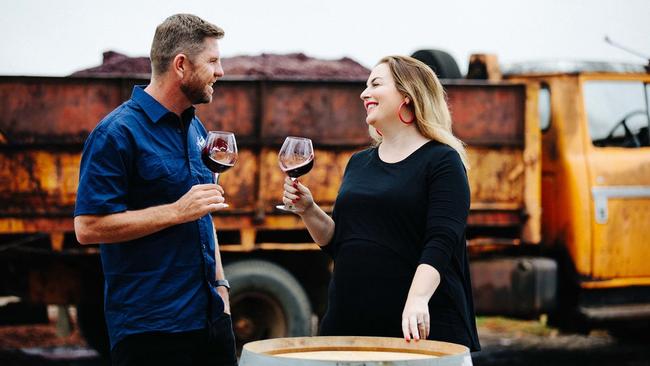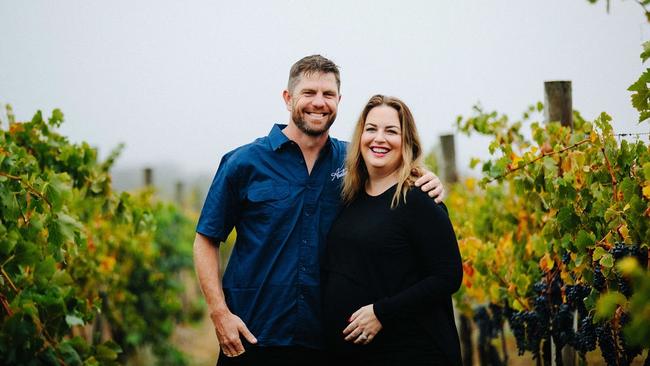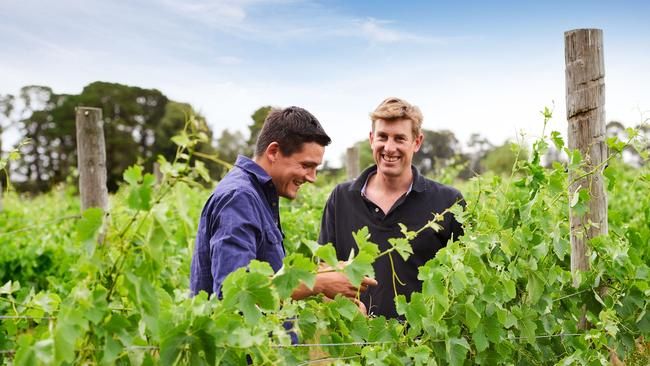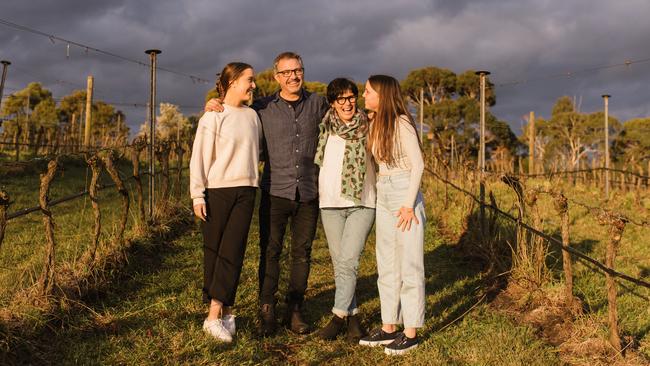How innovations will change Victoria’s wineries, cellar doors and wine regions
As our world-class wineries reopen after their hardest year on record, they are changing with the times — especially when it comes to cellar door tastings.

Lifestyle
Don't miss out on the headlines from Lifestyle. Followed categories will be added to My News.
When it comes to winemaking, Victoria is spoilt for choice.
There is the much-celebrated Yarra Valley, the cool climate of the Macedon Ranges and coastal areas including the Bellarine and Mornington peninsulas — and plenty of more in between.
The state has a remarkable diversity of growing conditions in its 21 wine regions, according to Wine Victoria chairwoman Angie Bradbury.
“There’s lots and lots of geographical and climatic differences in Victoria and that creates lots of different climates for growing grapes of all different varieties,” Ms Bradbury said.
Veteran wine writer James Halliday said in the past 30 years, the number of Victorian wineries had exploded.
“The regions are pretty well up against each other like pieces in a jigsaw puzzle,” Mr Halliday said.
“If you look at the regional map of Victoria, there’s no other place like it.”
But while they may be producing world-class wine from shiraz to sparkling and chardonnay, many wineries are facing their biggest challenge yet as they try to minimise the financial fallout from a year of setbacks.
“It’s been the most difficult year on record. Certainly in the 20 years I’ve been working in wine, I’ve never seen anything like this,” Ms Bradbury said.
“Usually we might have had bushfire — because we’ve certainly had that before. But we haven’t had bushfire, followed by a pandemic, followed by the trade issues and challenges with China. Every aspect of our industry has been impacted.”
But there have been exciting signs of innovation in Victoria’s wine industry, which directly employs 13,000 people and contributes $7.6 billion to the economy annually.
From online wine tastings to new partnerships between local producers, virtual cellar doors and seated tastings, plenty of barriers had been broken, Ms Bradbury said.
Meanwhile, wine critic Nick Stock pointed to a new generation of winemakers who were “reinterpreting existing regions, and evolving the wines being made”.
“In some cases it is the next generation of existing wine businesses coming into play. But in other cases, Victoria’s been a real talent magnet for people who want to make great wine,” Mr Stock said.

So how will Victorian wineries fare in coming years?
Ms Bradbury said only time would tell.
“It will very much depend on the ability for us to bounce back and have a really strong vintage 2021, and what happens with the domestic recovery,” she said.
For the moment, at least, rocking up to a winery and standing at the tasting counter to sample the wines was not possible, she said.
“One of the predictions for next year is that the traditional cellar-door experience is probably gone forever, in favour of more of a seated tasting, a longer and more in-depth experience,” Ms Bradbury said.
“People are willing to pay for it, too, and I think that’s a really good thing.”
NEXT-GEN WINEMAKERS THINK OUTSIDE THE BOX
Fancy a vine with your wine?
At Austin’s Wines in the Moorabool Valley, second-generation owners Scott and Belinda Austin are putting a modern spin on winemaking.
Even before COVID-19, the couple had introduced a rent-a-vine program, which encouraged wine lovers to get their hands dirty.
There have also been special edition wines featuring Gary Ablett and Richmond premiership captain Trent Cotchin — and now a crowd-funding campaign to turn their shearing shed into a cellar door.
The winemaking business has changed a lot since Mr Austin’s parents, Pamela and Richard, planted a small vineyard on a 2ha block in Waurn Ponds, near Geelong, in 1982.
In 1990, the founders moved it to the current site in the Moorabool Valley, where they established 60ha of vines over a five-year period.

Mr Austin took over ownership in 2008, eventually followed by his wife — and their three children.
“We love (Pamela and Richard’s) traditional values about wine, but Scott and I really have a modern approach,” Mrs Austin said. “We really try to think outside the box.”
She said they had evolved to keep up with customers who were no longer only diehard wine connoisseurs.
“Yes, they appreciate wine, they want to learn about it, but they want it to be done in a way that’s very approachable and understanding,” Mrs Austin said.
That flexible approach was a blessing this year as the winemakers switched to online sales, and teamed up with local producers to offer wine and cheese deliveries.
“We said if we sell 150 packs, we’ll be really happy,” Mrs Austin said. “I think to date we have sold 700.
“If we’ve survived this year, I think we could get through anything.”
MORE TO WINEMAKING THAN GROWING GRAPES
It is fitting that Alister Timms, who grew up planting vines at his family’s Kilgour Estate on the Bellarine Peninsula, is now a sought-after winemaker in his own right.
But, according to Mr Timms, the vineyard manager at Shadowfax Wines, there is much more to the job than simply growing grapes.
“It’s one of the only agricultural pursuits that you do the whole thing, from growing the grapes, making the decision to plant the vineyards and upscaling it, turning it into wine and actually selling it,” he said.
Shadowfax is well known for its popular restaurant and winery in Werribee, about half an hour’s drive from Melbourne’s CBD.
The vision of developer and investor Mark Robertson, the winery planted its first vines in 1998.

It opened its doors two years later, at the same time as the nearby luxury hotel now known as the Lancemore Mansion Hotel.
“We make wines from Werribee, but we also make wines from Macedon Ranges, which is the coldest place in mainland Australia to grow grapes,” Mr Timms said.
He has worked with Shadowfax for the majority of the past two decades, taking over as Shadowfax’s chief winemaker in 2017 after Matt Harrop left to join Curly Flat in the Macedon Ranges.
While Shadowfax makes a range of wines, its current bestseller is a pinot noir.
“People love that and there’s more people drinking pinot noir at the moment than ever before,” Mr Timms said. “There’s this lovely purity in it.”
While 2020 has been a battle, he said the support of Victorians — particularly Melburnians — throughout the pandemic had been humbling.
The reopening of the winery’s restaurant on October 29 has also provided a welcome boost.
PERFECT PINOT NOIR HITS PAY DIRT
Marcus Satchell, who runs Inverloch’s Dirty Three Wines with his wife, Lisa Sartori, never imagined he would own an winery.
“I just wanted to be a winemaker for someone else. I just never really felt I would have enough money to be able to do it,” Mr Satchell said.
But when the couple had twin girls almost 17 years ago, they felt the call to move back to South Gippsland, where they had grown up.

Mr Satchell, with two mates, had their first vintage with Dirty Wines in 2012, before Ms Sartori, a former bank manager, joined the fold in 2016.
“I realised that I didn’t have to have a super flash, amazing, incredible winery — if I was clever I could do things on a budget,” Ms Sartori said.
Dirty Three Wines, grown in the dirt of three vineyards, now sells about 2500 cases of wine a year in independent bottle shops, and from its popular “urban cellar door”
— an industrial shed in Inverloch.
Pinot noir is its specialty.
“I think one of the things about pinot is the pinot does taste where we come from,” Ms Sartori said. “So our pinots do taste significantly different to Yarra and Mornington, and all those places, they taste of South Gippsland.”
MORE NEWS
TELLING SIGN OUR WORLD-FAMOUS EATERIES WILL BOUNCE BACK
